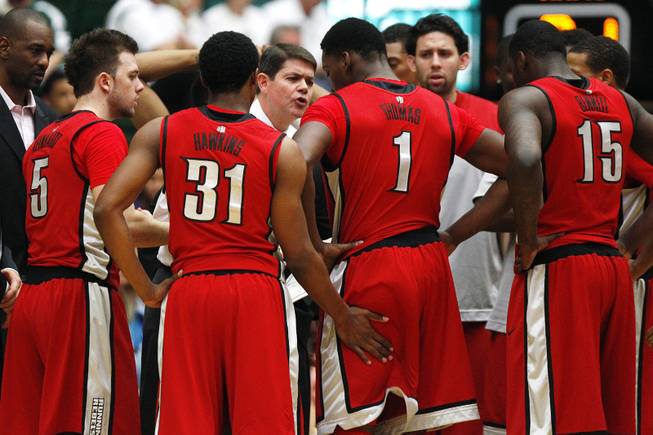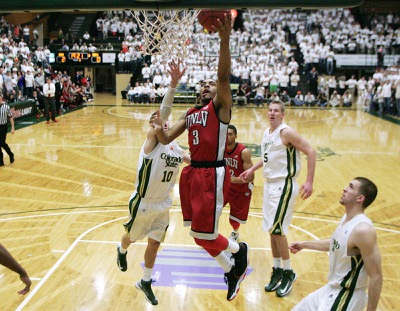
Sam Morris / Las Vegas Sun
UNLV head coach Dave Rice talks to his team during a timeout in the Rebels’ 66-61 loss to Colorado State on Saturday, Jan. 19, 2013, at Moby Arena in Fort Collins, Colo.
Monday, Jan. 21, 2013 | 2 a.m.
Related Coverage
- By the Numbers: UNLV’s loss at CSU contains many conflicting figures
- UNLV couldn’t keep Colorado State from playing its game in road loss
- Perimeter defense could be key against very tough Colorado State squad
- UNLV Extras: Rebels’ challenge now is to avoid emotional letdown
- Quirky lineup and determined point guard led UNLV to victory at SDSU
- After going 1-1 last week, Rebels fall out of Associated Press poll
- UNLV Leftovers: Season could hinge on results of next two games
- Rebels fit into some different roles and fend off Air Force in overtime
- Tale of UNLV’s league-opening loss can’t be told by one number alone
- All UNLV men's basketball coverage
If you’re worried or freaked out because UNLV went 2-2 to open league play, take a deep breath and count to 37. That’s how many at-large teams will get into the NCAA tournament, and the Rebels are still well within that field.
A .500 record over a stretch that includes likely the three toughest games of the entire league schedule is good enough, especially when it comes at the start. Of course, the Rebels would prefer to be 4-0. And I’d prefer to have summer homes in San Diego and Fort Collins (seriously, the Mountain West has some amazing cities).
Basically, everything is still in front of the Rebels (15-4, 2-2), and having those games behind them already should be a good thing going forward. Here are a couple of other observations from UNLV’s recent contests:
A noticeable absence
During the most important minutes of the past two, both winnable, games, UNLV junior forward Mike Moser has been on the bench. Despite Moser tweaking his previously injured right elbow against Colorado State, UNLV coach Dave Rice said after each game that Moser had been available.
Against San Diego State on Wednesday, Rice opted for a four-guard lineup late in the game. The move also put Anthony Bennett on the bench for the final 3:43 (Moser was out the last 7:06). That was an in-game decision Rice made to go small, and it paid off, which made Moser’s absence more of an afterthought following a big victory.
Against Colorado State on Saturday, Moser was on the bench for the final 6:30. It’s impossible to say whether playing Moser down the stretch would have led to a UNLV victory, but the fact the Rebels lost highlights the decision to go without the 2012 first-team all-league choice.
Moser has had a frustrating season. He was averaging nearly a double-double through six games, though that also included 2.3 turnovers per game and an up-and-down field-goal percentage. Then Moser dislocated his right elbow at Cal, and since then it’s been a battle to get comfortable on the court.
Moser played spot minutes at North Carolina and at New Mexico, then played 40 minutes in the home overtime victory against Air Force. He had 14 points and 11 rebounds in that game, though it was inefficient — 6-for-14 on 2s, 0-for-4 on 3s, 2-for-7 on free throws — and earned him a paltry 76 Offensive Rating, according to kenpom.com.
Still, it seemed like a positive step toward moving back to regular starters’ minutes. Then came foul trouble and the small lineup at SDSU and the elbow scare at CSU.
It would have been unfair to expect Moser to jump right back in, but as UNLV exits its much-discussed four-game league debut and approaches February, it’s fair to wonder about Moser’s role the rest of the season and his plans for next year.
There’s still time for Moser to show the pro potential that had him nearly declare for the NBA draft last season. It just hasn’t made an appearance in a while.
Reports from the field
There are a lot of factors that go into winning or losing a basketball game. Although players and coaches may say differently, these usually change a bit on the road due to the extra challenges such as home-court advantage or fatigue.
One thing that’s always important, and something UNLV struggled with in nearly every road conference game last year, was field goal percentage. Admittedly this isn’t a perfect stat, but with only a few exceptions, a team's chance of victory rises along with its shooting percentage.
In that regard, the Rebels have made a decent improvement in three road Mountain West games this year. Here was the team’s field goal percentage last season against the same three teams it has faced this year:
1/14 at San Diego State: 35.3
2/18 at New Mexico: 31.1
2/29 at Colorado State: 39.3
The common denominator, other than the fact that they’re all under 40 percent, is that all three were losses. They’re also spread out through the conference season, indicating this was a long trend and not just a short funk. UNLV opened the conference season with the loss at SDSU; the defeat at New Mexico, which is the only road league game under Rice decided by more than seven points*, was the team’s third straight road loss.
Fast forward to this season and the results are a little better — 1-2 vs. 0-3 — and the Rebels’ field goal percentage is up across the board:
1/9 at New Mexico: 40
1/16 at San Diego State: 51.6
1/19 at Colorado State: 41.1
Keep in mind that while UNLV is a markedly different squad from last season, all three of these teams are very similar, with only one or two changes in their rotations.
Based on results, you already know this doesn’t mean UNLV has solved its road issues. But last season, the Rebels couldn’t win games a lot of times simply because they shot themselves out of games. And early indications are that won’t be as much of a problem this time around.
*The Rebels are 3-7 under Rice on the road in conference play. The margin of defeat in those seven games is 6.6 points per game, and it’s 4.3 ppg if you throw out the 20-point loss at New Mexico. Throw in the wins without that lopsided defeat and the margin, win or lose, is 4.4 ppg. Which is to say nothing has come easy.
Taylor Bern can be reached at 948-7844 or [email protected]. Follow Taylor on Twitter at twitter.com/taylorbern.



Join the Discussion:
Check this out for a full explanation of our conversion to the LiveFyre commenting system and instructions on how to sign up for an account.
Full comments policy